
The Teachers Grammar Book - James Williams
.pdf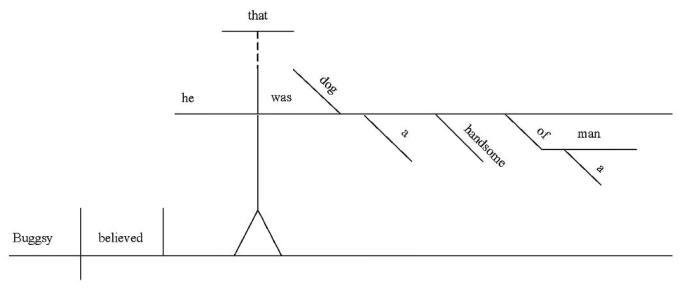
Sentence 4.8: Buggsy believed that he was a handsome dog of a man. (Reed-Kellogg diagram)
109
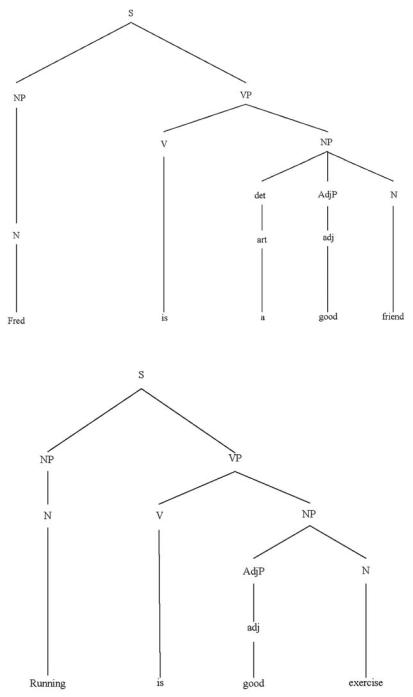
Sentence 4.6: Fred is a good friend. (Tree diagram)
Sentence 4.7: Running is good exercise. (Tree diagram)
110
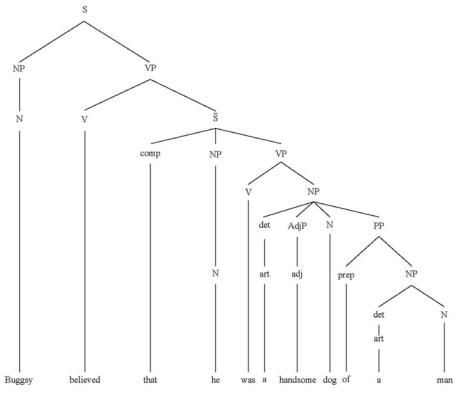
PHRASE STRUCTURE GRAMMAR |
111 |
Sentence 4.8: Buggsy believed that he was a handsome dog of a man. (Tree diagram)
VP Æ V (NP) (AdjP) (PP)
The only thing we have to keep in mind with these rules is that, for indirect objects that appear as a noun phrase rather than as a prepositional phrase, we add another noun phrase to the analysis. Consider this sentence:
9. Fritz sent his grandmother a gift.
This sentence has a verb phrase of the form V NP NP. The corresponding diagram is on page 112.
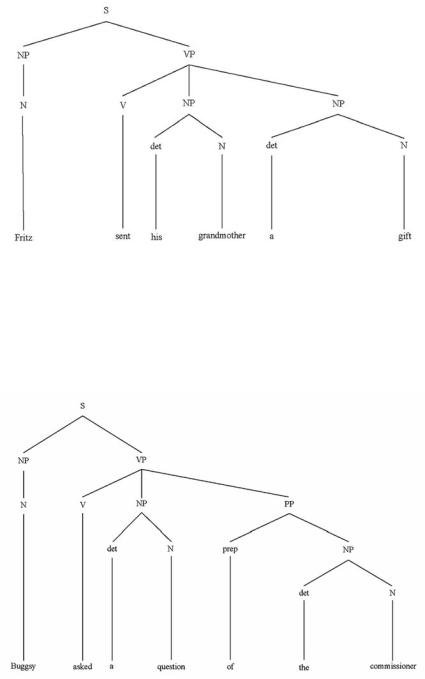
Sentence 4.9: Fritz sent his grandmother a gift.
Now consider sentence 10, which is an example of an indirect object in the form of a prepositional phrase. Compare its associated diagram with the diagram for sentence 9.
10. Buggsy asked a question of the commissioner.
Sentence 4.10: Buggsy asked a question of the commissioner.
112
PHRASE STRUCTURE GRAMMAR |
113 |
Prepositional Phrases
Prepositional phrases (PP) are interesting structures because they are so versatile. They can function as indirect objects, and they also can function as adverbial modifiers and as adjectival modifiers. As adverbials, they can function as sentence-level modifiers, which means that they can modify an entire clause. In chapter 3, we discussed phrasal modifiers and noted that the prepositional phrase is one of the major types. As indicated in that discussion, prepositional phrases can appear in the initial, medial, or final positions. When they appear in the initial positions, prepositional phrases are sentence-level modifiers. Sentences 11 through 15 illustrate the various positions and forms that prepositional phrases can take:
11.The goons put yellow flowers on the table. (adverbial)
12.Macarena, with a smile, accepted the invitation. (adverbial)
13.The woman with the red hair drives a Porsche. (adjectival)
14.In the morning, Buggsy went home. (sentence level, adverbial)
In addition, prepositional phrases can function as complements to certain kinds of verbs, as in sentence 15:
15. Fred stepped onto the stool. (verb complement, adverbial)
Usage Note
Before the advent of printing, handwritten books were valued as much as works of art as storehouses of information. They were beautifully illustrated, and the monks who produced them took great pride in the quality of their calligraphy. Anyone who views some of these books in a museum will notice that the calligraphy is so uniform as to rival mechanical printing. As literacy spread and became more utilitarian during the 15th and 16th centuries, there arose a demand for more readable and less expensive works. Punctuation emerged as a means of making books more readable, as did a significant reduction in the amount of artwork. Paragraphs, which were unknown in the ancient world, also became a means of helping readers process texts.
The lesson we learn from this brief discussion is that punctuation is largely a matter of convention rather than of rule. Indeed, different conventions govern punctuation in several contexts. Journalists, for example, follow the Associated Press convention when using commas with items in a series and do not put a comma before the conjunction joining the last item;

114 |
CHAPTER 4 |
those who follow the MLA and the APA conventions, on the other hand, do put the comma before the conjunction.
With regard to prepositional phrases, there are two conventions governing punctuation of phrases in the initial position. One holds that writers should use length as the basis for deciding whether to set the modifier off with a comma. In this convention, short structures are not set off, whereas long ones are. Although this approach is perfectly acceptable, it creates problems for teachers whose students want as much consistency as possible.
Another convention holds that all modifying structures at the beginning of sentences should be set off with a comma. Many teachers have adopted this convention because it is easier to teach, or at least it is easier for students to accept. They do not have to think about length.
Ambiguity
Language is inherently ambiguous, but certain prepositional phrase constructions are quite obviously so. Under normal circumstances, we use context to disambiguate such constructions, but it is possible to provide a grammatical analysis that also disambiguates. Consider the following sentences:
16.Fred built the bench in the garage.
17.Macarena put the shoes in the box in the closet.
All ambiguous sentences have two possible meanings.1 In sentence 16, one meaning could be that the act of building the bench could have taken place in the garage. The second meaning could be that the act of building could have occurred anywhere other than the garage, but the bench is in the garage now. In sentence 17, the shoes already could be in the box, and Macarena put those particular boxed shoes in the closet. The other meaning could be that the empty box already could be in the closet, and Macarena put the shoes in that box.
We can use grammatical analysis to disambiguate sentences like 16 and 17 because each possibility has a different phrase-structure, as illustrated in the diagrams on pages 115 and 116.
COORDINATION
Coordination is one of the more common features of language, and phrasestructure grammar provides a rule that is generally applicable to all coordinated
1Although the possibility exists for more than two meanings, examples are so rare that none could be found for this text.
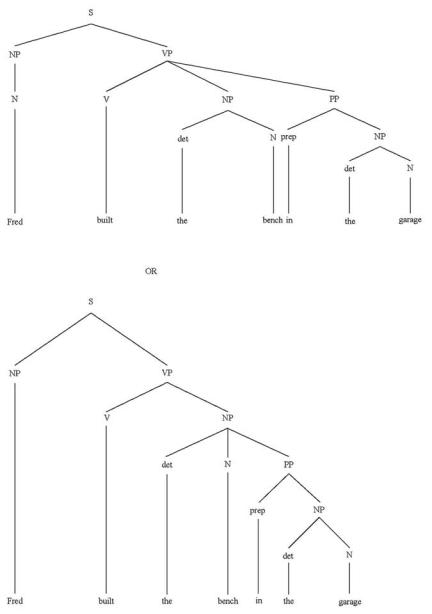
Sentence 4.16: Fred built the bench in the garage.
115
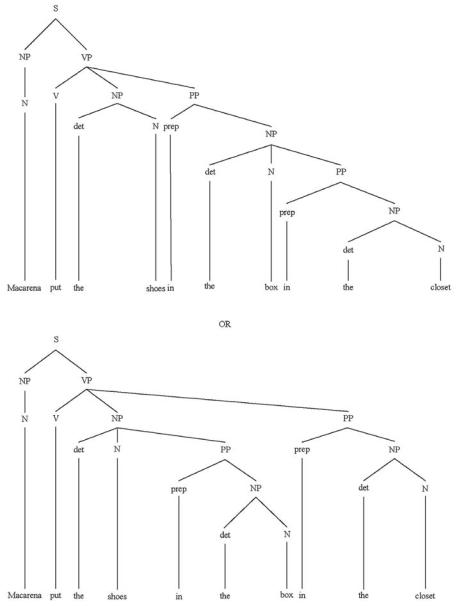
Sentence 4.17: Macarena put the shoes in the box in the closet.
116
PHRASE STRUCTURE GRAMMAR |
117 |
structures. It is called the Coordinate XP rule, where X is a variable identifying any element, such as noun or verb, and P is phrase. Coordinating conjunctions are designated by CC. This rule supplies two pieces of information. First, any phrase can be conjoined to another phrase of the same form. For example, any two noun phrases can be linked using a coordinating conjunction. Second, the two conjoined phrases function as a single unit that has the character of the individual phrases. In other words, two noun phrases joined by a coordinating conjunction function as a single noun phrase. The rule is shown as:
XP Æ XP CC XP
We can see how the XP rule works in sentences 18 through 20. In 18, the subject is Fred and Fritz, which exists as a single unit and can be represented by XP. But the subject consists of the two noun phrases: Fred and Fritz.
18. Fred and Fritz loved Cheerios.
The sentence grammar for 18 would be:
S Æ NP CC NP VP
NP Æ N
VP Æ V NP
Because language is inherently recursive, we can combine any number of similar phrases in a single unit, as shown in sentence 19:
19. Macarena danced, laughed, and sang at the party.
We would describe the grammatical structure of 19 as follows:
S Æ NP VP
NP Æ (det) N
VP Æ VP VP CC VP PP
PP Æ prep NP
Compound Sentences
The Coordinate XP rule also applies to entire clauses, giving us a way of describing the grammatical structure of compound sentences. A compound sentence is one that has two independent clauses. The analysis proceeds in

118 |
CHAPTER 4 |
exactly the same way as we saw earlier, but rather than repeating phrases, the rule repeats sentences.
Consider sentence 20:
20. A goon shot the ATM, so Buggsy made an easy withdrawal.
Because each clause has the structure of a sentence, by convention our grammar would begin with:
S Æ S1 CC S2
What this means is simply that the sentence (S) consists of two clauses (S1 and S2). The grammatical analysis for 20 then would proceed like those shown earlier:
S1 Æ NP VP
S2 Æ NP VP
NP Æ (det) (AdjP) N
VP Æ V NP
AdjP Æ adj
Teaching Tip
Tree diagrams can help students better understand the nature of compound sentences. If we diagram sentence 20, for example, the tree clearly shows how the sentence is composed of two equal Ss, or clauses. When students understand the structure of compounds, they more readily understand how to punctuate them correctly.
